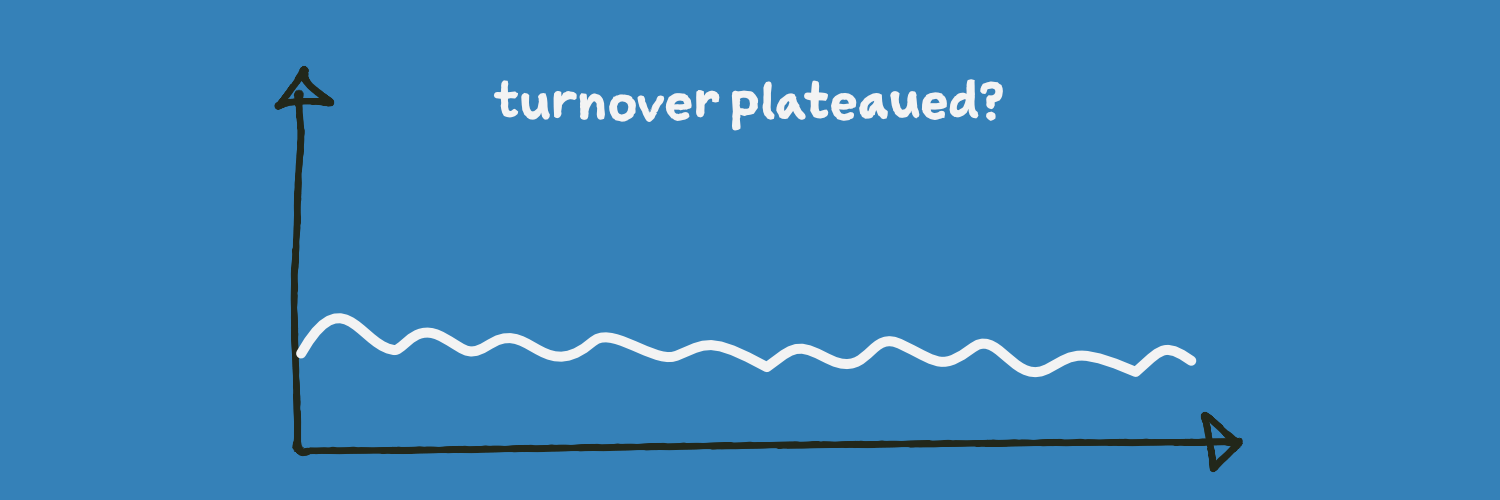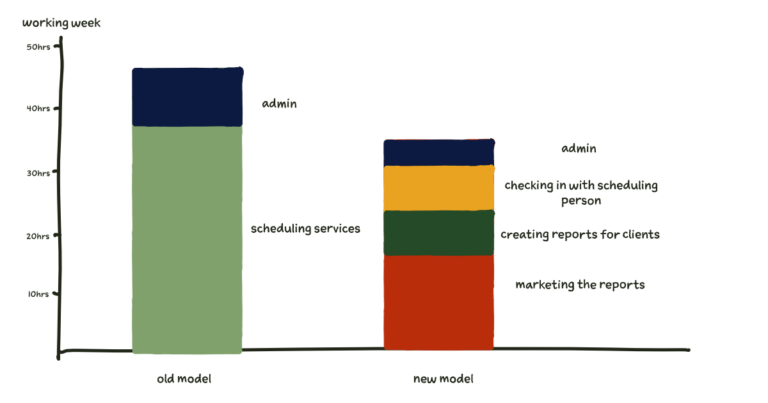Has your turnover plateaued out?

Suzi* ran a social media scheduling service. She’d built up some good clients and had monthly recurring revenue. And she’d been fully booked for a couple of years. Clients tended to stay for a long time, and she had a waiting list of people to fill any gaps that came up.
Not a bad place to be…
But.
Being fully booked means that your turnover plateaus. While, like the rest of us, Suzi’s living costs have risen.

Real holidays, not remote working
Suzi had started this work originally because she liked to travel. She’d never gone completely digital nomad, but she’d been able to still work while taking extended trips around the world. But now Suzi wanted to settle down a bit more. She was thinking about buying a house with her partner and slowing down on her sometimes relentless pace of working. I remember being impressed by all the places in the world she’d visited and then smiling when she said, “I want to go on holiday and not work while I’m there. Like normal people do.”
I knew exactly what she meant. For years, I found it difficult to take time off because I felt I had to be at my desk for clients.
What Suzi did next
Suzi trained someone else to do her social media scheduling work, so she still had some income, even after paying her new employee.
Then, she developed her first product, an analytics service for mid-sized companies that wanted more information from their social media analytics.
“It’s the tool I’ve been looking for to do the reports for my clients, but it doesn’t seem to exist for the mid-sized companies I work with.”
Suzi spent three months researching the market and working out how to make what she wanted. She loved processes and numbers, so she taught herself how to use Zoho business intelligence software to generate accessible and good-looking reports. Her first customers were her existing clients, who thought she was still doing their scheduling.
They were the beta testers for the new product, although they didn’t know that she was testing it on them. With these paying beta testers, Suzi could be pretty confident when she puts the product on sale more widely.
A year later
One year later, Suzi’s working week looks like this

But, her working week had shrunk. Suzi used to work 35-50 hours a week, but now she’d given those more basic tasks to her employees to do. The reports only took 30 minutes each to check and write the recommendations for the clients, and the rest of Suzi’s time was spent on marketing the new tool.

How are things now?
Suzi still hasn’t got to the point where she feels she can take those delightful100% time off, no looking at emails type holidays. She still has it as a goal for the next stage, though.
But she can go on holiday, stay in a very nice hotel, and work for an hour each day after breakfast before spending the rest of the day doing whatever “normal people” do on holiday.
What we learn from Suzi
There are quite a few lessons for the rest of us in Suzi’s productising journey. I was particularly struck by how Suzi had managed to make this easy(ish) for herself. Sometimes, the pressure to maintain our turnover levels or to go too far outside our comfort zone can be too much for us, and this can be a major cause of failure. I explain a bit more about this in this video (note the reference to the Vulcan mind meld, particularly helpful here.)
Canny decisions we can emulate
Susi made a canny decision when she delegated all her existing client work to a new employee. That freed up her time to work on the products, maintain her turnover and keep all her clients so she could upsell them the new productised reports. It did mean a dip in her net profit of course, because she had to pay the new person. But Suzi was canny here as well and took on someone she could train up, and therefore, the starting salary wasn’t too much of a chunk of Suzi’s turnover, and she could still pay herself a decent amount each month.
This is a different story for some of my clients who have decided to ditch their existing clients while they work on the products. That can work as well, especially for people who feel that they’ve got a bit bored with the client work they’ve often been doing for years.
I also loved that Suzi did a beta test of her new products on her existing clients without them even realising. They saw the new reports as a fabulous new thing that Suzi had created, and because they already loved her work, they had no doubts about paying a little extra for the improved reports. Which, in a way, is hilarious because the reports reduced the amount of time Suzi and her employees were spending per client, but she got them to pay more money. I love it.
If you’re doubting whether this whole idea of charging more money for spending less time is ethical, I’m going to ask you to remember that the clients were getting something more useful for them (cos the reports were better). And then maybe take a look at my blog about trading our time for money.
What next for Suzi?
As I’m sure you’ve guessed, I’ve advised Suzi that she needs more than one product in her product ecosystem to make sure that her business is resilient and as profitable as possible. At the moment, she’s still working on marketing her reports and building up customers for them. There seems to be a lot of scope for it. The last time we spoke, she said she might take on another employee, get them to do the scheduling work she used to do and promote the first employee to doing the recommendations part of the reports. The business then starts to look more like the Charlie’s Angels model of productised services, which gives Suzi a lot more free time and makes the business much more scaleable.
How Charlie’s Angels could help you productise your business
Your next steps
There are tons of other success stories here on the blog and on the Adventures in Products YouTube channel. When you want to really get going with this, you should dig in deep with the Pivot to Products self-study course, which takes you through the principles of productising and teaches everything I wish I’d known when I got started back in 2014.
*Not her real name. Suzi didn’t want to disclose all her details for this productising success story, so I’ve changed her name and details of the business to maintain confidentiality. The important bits are all true.
Here are other lovely examples of productised services
How Tim Healey built his product ecosystem
Cautious Ahmed and the recurring revenue productised services
